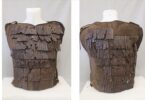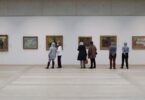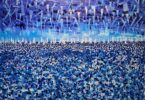Razmig Bedirian
In Shadow Sites II, Jananne Al-Ani presents desert terrains in Jordan from a vantage point that is as haunting as it is mesmerising, especially considering its implications.
The video artwork features a bird’s-eye perspective of the sandy expanses, with the camera roving across them at a languid and observant pace. The landscapes are lined and dotted with structures and patterns, such as roads and tilled fields. The low sun casts long and oblique shadows that accentuate the forms.
The piece by the Irish-Iraqi artist is one of the first in a new exhibition at Jameel Arts Centre in Dubai, running until September 29. An introduction to the At the Edge of Land show, Shadow Sites II lays the groundwork for its focus. While Al-Ani utilises a technique called shadow relief (meaning aerial footage filmed when the sun is at a low to pinpoint buried sites) in her work, the collection at large unearths stories of conflict, erosion and extraction by observing landscapes.

Fitting, then, that Al-Ani’s technique originated during the First World War, as reconnaissance missions sought to locate trenches and other military positions. In her turn, the visual media artist employs the method to reveal an unsettling truth of how the region has often been represented in the West. Her work touches on the nature of satellite imagery in the Levant; terrains appear barren and lifeless.
Shadow relief may accurately identify human presence, but nevertheless, its aerial views of a landscape flatten a physical space. Entire countries’s vibrancy is minimised to stretches of sand and stone. Even when human activity is identified, its objectives are often malicious and militaristic.
In At the Edge of Land’scuration, Shadow Sites II is potently placed immediately after the Untitled painting by Aref El Rayess, a Lebanese artist who lived in Saudi Arabia in the 1980s. It’s one in a series of 300-some works studying Saudi landscapes. Untitled shows rocky heights, ochre expanses and ruins. The scene is reminiscent of landscapes in Tabuk, in north-western Saudi Arabia. The architecture featured in the painting also alludes to the region’s structures but with a more sci-fi bend. With lush oasis patches and arresting architecture, El Rayess presents the vibrancy and depth of the desert – flattened to a reductive plain upon the next turn with Al-Ani’s work.

It’s one of many potent juxtapositions in the exhibition. Here, curator Lucas Morin dedicates the space to making obvious the connections between landscapes and trade, moving from land to sea. Featuring 20 artists from around the world, the show was first presented in Jeddah’s Hayy Jameel and has now moved to the gallery located in Dubai’s Jaddaf Waterfront, with a few additional artworks added.
“You realise that those two works, which may come from very different geographies, share a concern for landscape or even share a colour palette,” says Morin. Inspired by his own art collection, the idea for the exhibition was born as Morin noticed certain thematic threads between the disparate works.
Exhibition pieces that reverberate between each other include Sarker Protick’s Of River and Lost Lands and a series of works by Sim Chi Yin. While Chi Yin looks at the effects of illegal sand mining from a top-down view, Protick’s photography gets up close and personal with the devastation it causes.
A Bangladeshi photographer and visual artist, Protick spent more than a decade researching the erosion affecting the densely populated banks of Padma River delta. His work presents sprawling landscapes of shorelines encroaching on homes. Whole houses have toppled into the river, their bare windows facing the sky. Bulldozers have advanced to the bank’s edge, and only terrains of loose bricks and building materials remain. Pictures show landscapes verging on horror scenes.

Next, Chi Yin’s work presents a zoomed-out perspective on the problem. Her photography shows areas of construction and land reclamation, highlighting how countries like her native Singapore import sand from India, Cambodia, Vietnam or Italy. Much like in Protick’s series, it draws attention to mining’s impact on erosion, and therefore on the stability of homes and ecosystems.
This conscious curatorial approach is sustained throughout At the Edge of Land.
Take the series of drawings displayed by Filipino artist Joar Songcuya, touching on his decade-long experience as a seafarer and marine engineer. His artistic practice began as a way to pass the time and escape the adversities of life at sea, and now he works as a full-time artist inspired by memories of time spent at the Red Sea, the Suez Canal and Saudi Arabian ports.
In his work, many of which are self-portraits, Songcuya captures the emotions that emanate from the hardships of manual labour aboard ships. The artworks provide an individual’s perspective of a trade that many following works likewise reflect on.

It is at this point of the exhibition that the works move steadfastly towards the sea.
In Pirates, the Trembling Ship and their 1001 Nights I: Rock and Row, Au Sow Yee narrates a fictional story of an 18th-century pirate named Abdullah Al Haj, alluding to the maritime network of the British Empire.
Ranjit Kandalgaonkar, meanwhile, explores the destinies of decommissioned ships, showing how they are brought ashore and dismantled. The artist leaps towards magical realism, depicting ships as sea monsters and whales in several drawings.
Hira Nabi also examines the nuances of ship-breaking, namely the dismantling of the Ocean Master at the Gadani shipbreaking yards in her native Pakistan. In the video installation, Nabi presents the Ocean Master with a voice, spurning conversations between the ship and the labourers dismantling it.
The exhibition closes with a video work by Pakistani artist Lala Rukh. Surprisingly, the serene seascape was also filmed at the Gadani shipbreaking yards, though it’s unlikely a viewer will decipher this. Showcasing her preoccupation with time and light, Rukh edited the footage on-site, pausing the video and re-recording as the sun shifted its position in the sky.
Displayed on a vintage television in the corner, Rukh’s work is a reflective and poetic conclusion to At the Edge of Land. With the tide gently curling towards the shore, the landscape she captures seems unperturbed by human intervention.
After the exhibition delves into humans’ monetisation of landscapes at a later price, Rukh’s work captures the wonders of the natural world. It’s an implicit reminder of our collective need to be more thoughtful with how we conduct large-scale projects and sustain international trade.
Courtesy: thenationalnews







